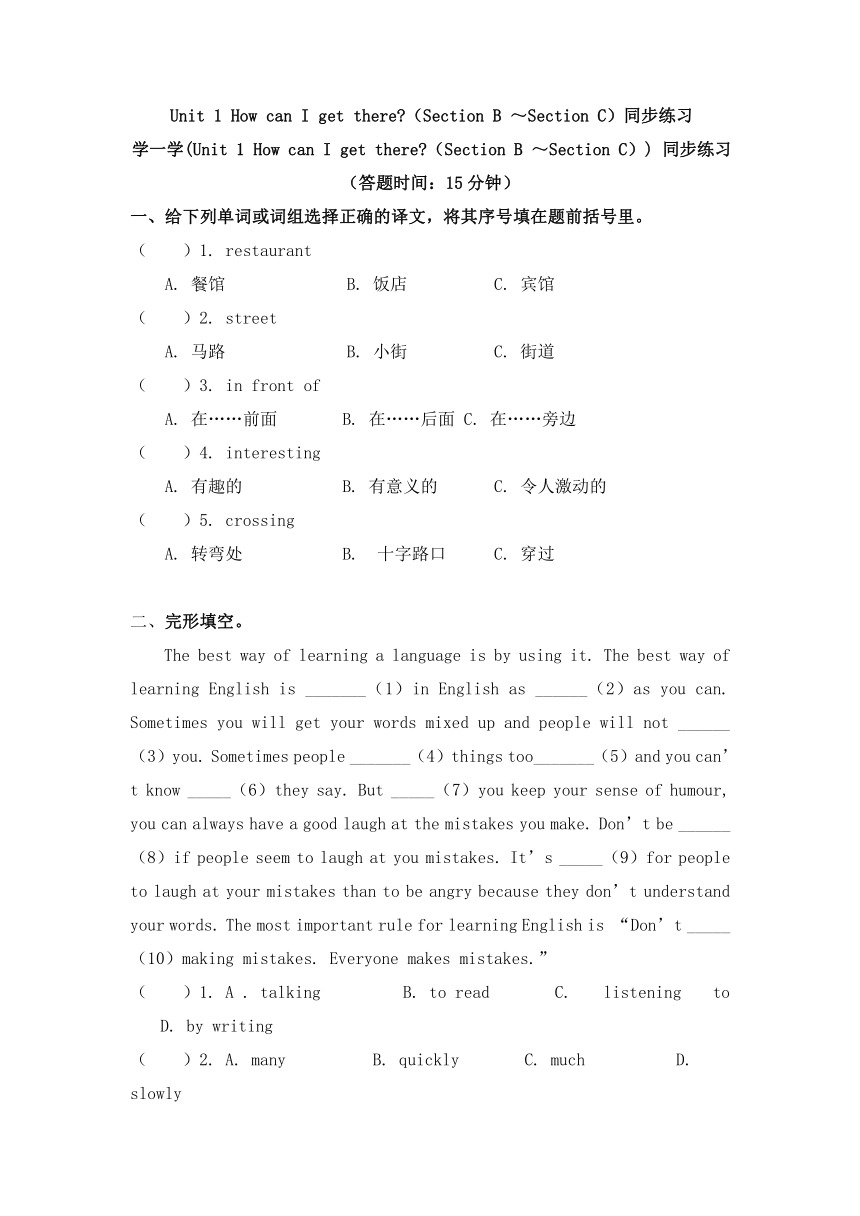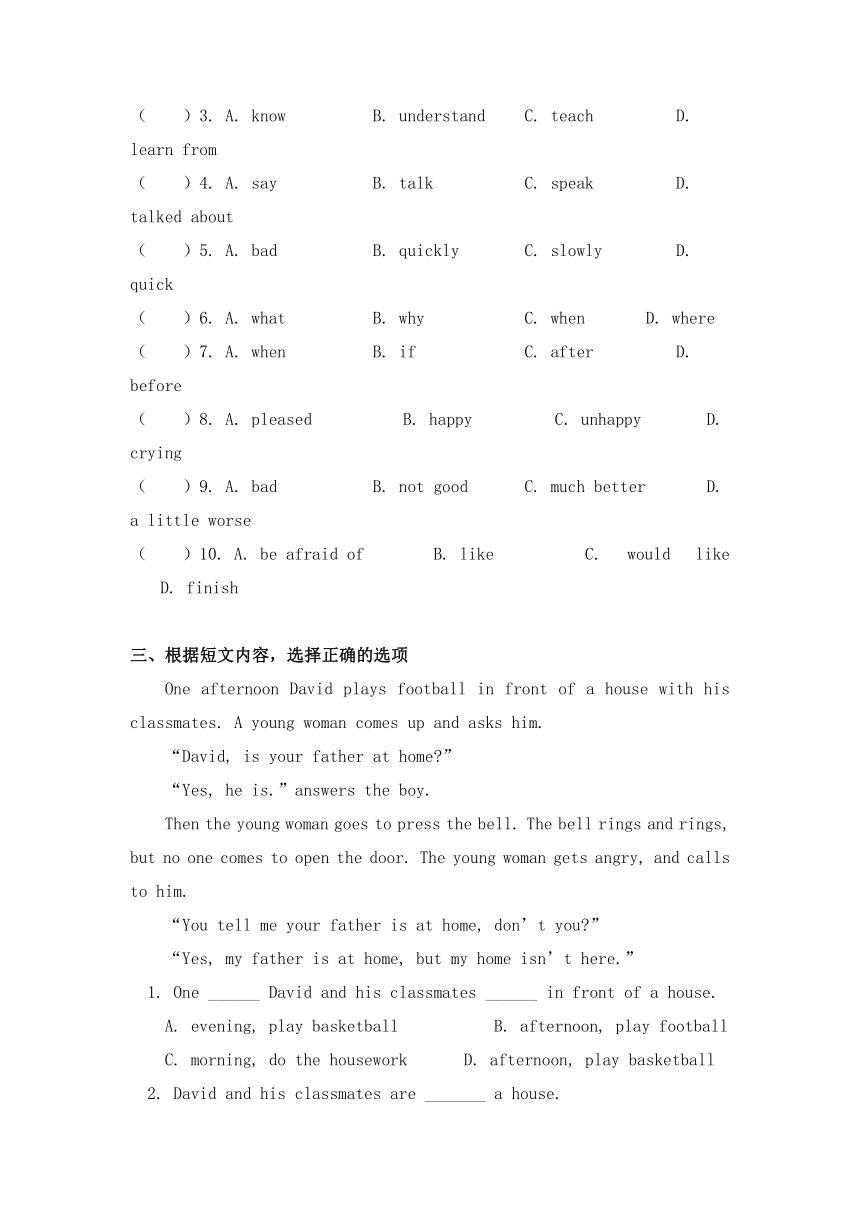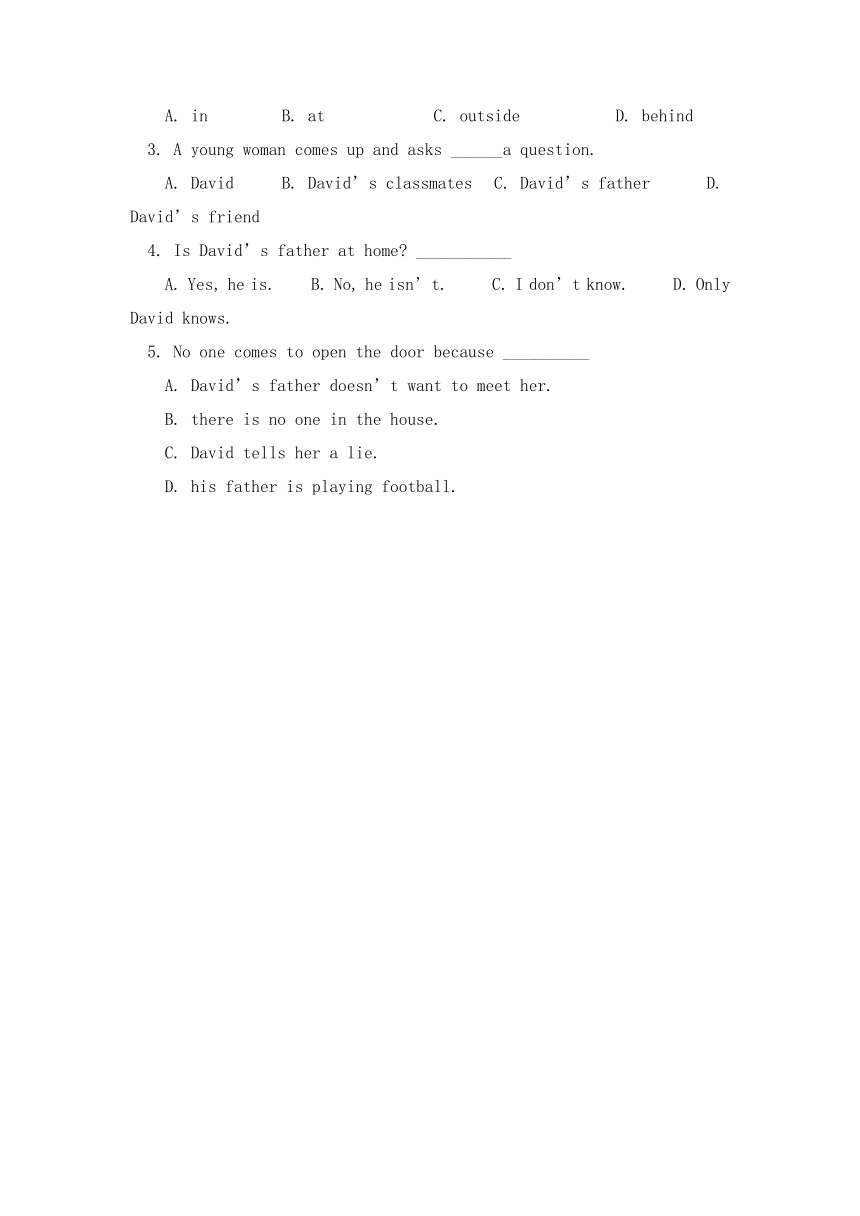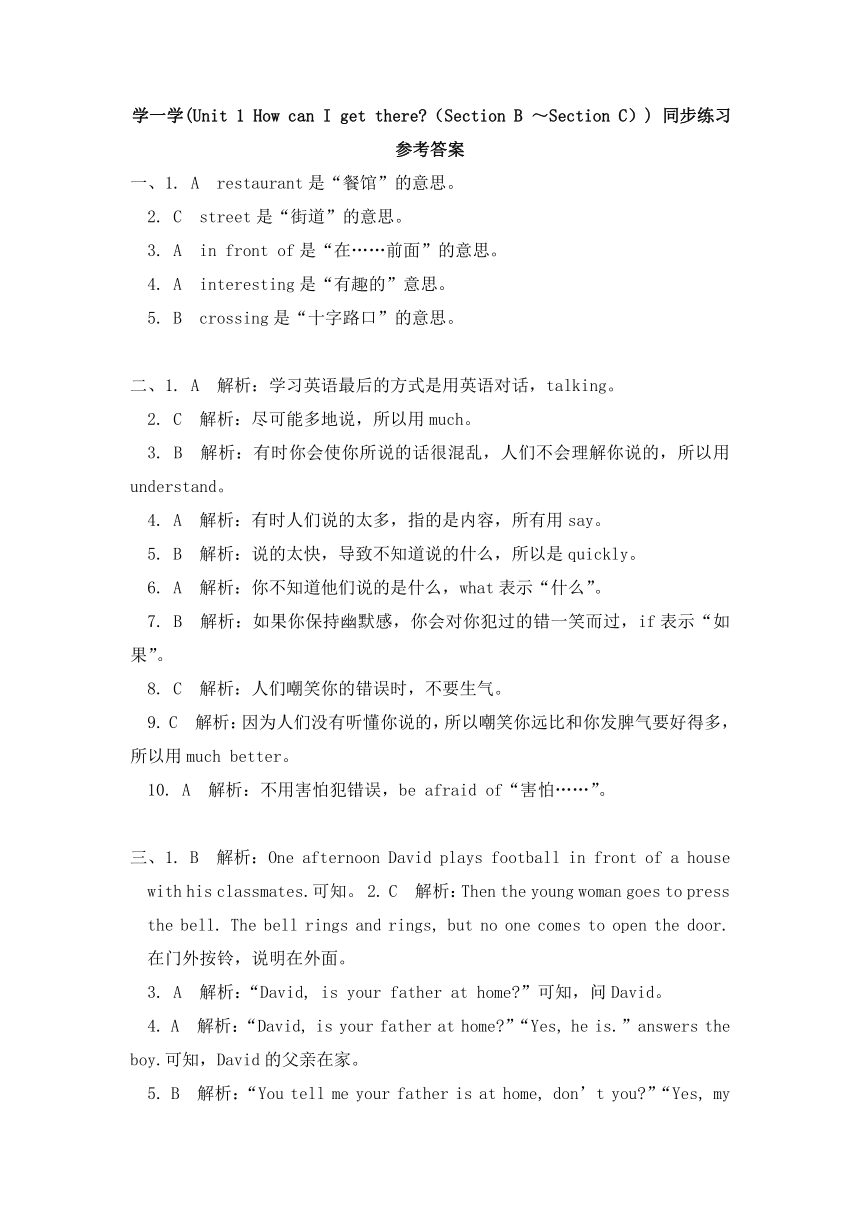Unit 1 How can I get there Part B ~Part C 同步练习(含答案 )
文档属性
| 名称 | Unit 1 How can I get there Part B ~Part C 同步练习(含答案 ) |  | |
| 格式 | doc | ||
| 文件大小 | 91.0KB | ||
| 资源类型 | 教案 | ||
| 版本资源 | 人教版(PEP) | ||
| 科目 | 英语 | ||
| 更新时间 | 2020-08-11 12:40:09 | ||
图片预览





文档简介
Unit 1 How can I get there?(Section B ~Section C)同步练习
学一学(Unit 1 How can I get there?(Section B ~Section C)) 同步练习
(答题时间:15分钟)
一、给下列单词或词组选择正确的译文,将其序号填在题前括号里。
( )1. restaurant
A. 餐馆 B. 饭店 C. 宾馆
( )2. street
A. 马路 B. 小街 C. 街道
( )3. in front of
A. 在……前面 B. 在……后面 C. 在……旁边
( )4. interesting
A. 有趣的 B. 有意义的 C. 令人激动的
( )5. crossing
A. 转弯处 B. 十字路口 C. 穿过
二、完形填空。
The best way of learning a language is by using it. The best way of learning English is _______(1)in English as ______(2)as you can. Sometimes you will get your words mixed up and people will not ______(3)you. Sometimes people _______(4)things too_______(5)and you can’t know _____(6)they say. But _____(7)you keep your sense of humour, you can always have a good laugh at the mistakes you make. Don’t be ______(8)if people seem to laugh at you mistakes. It’s _____(9)for people to laugh at your mistakes than to be angry because they don’t understand your words. The most important rule for learning English is “Don’t _____(10)making mistakes. Everyone makes mistakes.”
( )1. A . talking B. to read C. listening to D. by writing
( )2. A. many B. quickly C. much D. slowly
( )3. A. know B. understand C. teach D. learn from
( )4. A. say B. talk C. speak D. talked about
( )5. A. bad B. quickly C. slowly D. quick
( )6. A. what B. why C. when D. where
( )7. A. when B. if C. after D. before
( )8. A. pleased B. happy C. unhappy D. crying
( )9. A. bad B. not good C. much better D. a little worse
( )10. A. be afraid of B. like C. would like D. finish
三、根据短文内容,选择正确的选项
One afternoon David plays football in front of a house with his classmates. A young woman comes up and asks him.
“David, is your father at home?”
“Yes, he is.”answers the boy.
Then the young woman goes to press the bell. The bell rings and rings, but no one comes to open the door. The young woman gets angry, and calls to him.
“You tell me your father is at home, don’t you?”
“Yes, my father is at home, but my home isn’t here.”
1. One ______ David and his classmates ______ in front of a house.
A. evening, play basketball B. afternoon, play football
C. morning, do the housework D. afternoon, play basketball
2. David and his classmates are _______ a house.
A. in B. at C. outside D. behind
3. A young woman comes up and asks ______a question.
A. David B. David’s classmates C. David’s father D. David’s friend
4. Is David’s father at home? ___________
A. Yes, he is. B. No, he isn’t. C. I don’t know. D. Only David knows.
5. No one comes to open the door because __________
A. David’s father doesn’t want to meet her.
B. there is no one in the house.
C. David tells her a lie.
D. his father is playing football.
学一学(Unit 1 How can I get there?(Section B ~Section C)) 同步练习
参考答案
一、1. A restaurant是“餐馆”的意思。
2. C street是“街道”的意思。
3. A in front of是“在……前面”的意思。
4. A interesting是“有趣的”意思。
5. B crossing是“十字路口”的意思。
二、1. A 解析:学习英语最后的方式是用英语对话,talking。
2. C 解析:尽可能多地说,所以用much。
3. B 解析:有时你会使你所说的话很混乱,人们不会理解你说的,所以用understand。
4. A 解析:有时人们说的太多,指的是内容,所有用say。
5. B 解析:说的太快,导致不知道说的什么,所以是quickly。
6. A 解析:你不知道他们说的是什么,what表示“什么”。
7. B 解析:如果你保持幽默感,你会对你犯过的错一笑而过,if表示“如果”。
8. C 解析:人们嘲笑你的错误时,不要生气。
9. C 解析:因为人们没有听懂你说的,所以嘲笑你远比和你发脾气要好得多,所以用much better。
10. A 解析:不用害怕犯错误,be afraid of“害怕……”。
三、1. B 解析:One afternoon David plays football in front of a house with his classmates.可知。 2. C 解析:Then the young woman goes to press the bell. The bell rings and rings, but no one comes to open the door. 在门外按铃,说明在外面。
3. A 解析:“David, is your father at home?”可知,问David。
4. A 解析:“David, is your father at home?”“Yes, he is.”answers the boy.可知,David的父亲在家。
5. B 解析:“You tell me your father is at home, don’t you?”“Yes, my father is at home, but my home isn’t here.”可知,David的父亲在家,但David的家不在这。
说一说(Unit 1 How can I get there?(Section B ~Section C)) 同步练习
(答题时间:15分钟)
一、选择正确答案,将其答案填在横线上。
1. I want to go to Beihai Park. How can I _______(get, get to) there?
2. A: Excuse me. How can I _______( get, get to) Beijing Railway Station?
B: Go ______( to, down) this street, take the ______(two, second) turning ______( on, in )your right and you’ll see it.
二、根据汉语意思,补全对话内容。
A: Excuse me. How can I ____________?(到那儿去)
B: Sure. It’s not far _______ here. (很远)Go _______ this street, (沿着)turn left at the??first _______.(十字路口) It's Beijing Station.
A: Thank you.
B: You’re ____________.(不客气)
三、 阅读短文,根据短文内容,选择最佳答案。
A young man was sitting in a bus one morning. An old lady got in the bus and stood in front of him. The young man stood up. The lady pushed him back into his seat and said, “Don’t stand up. I don’t want to sit down.”
The man stood up again. The lady pushed him down and said, “You don’t have to give me your seat. I like to stand.”
The man tried to stand up for the third time. The lady tried to push him down again. The man shouted, “ Don’t push me, please. I have to get off the bus!”
1. Where did this story take place? _________
A. In the subway B. In the bus C. In the concert
2. Why did the young man stand up? _________
A. He wanted to give his seat to the old lady.
B. All the seats were full.
C. He had to get off the bus.
说一说(Unit 1 How can I get there?(Section B ~Section C)) 同步练习
参考答案
一、1. get,去那里,固定搭配get there。
2. get to,到……; down,沿着这条街向下走; second,第二个路口; on,在你的右边,固定搭配on your right。
二、1. get there,到那。
2. from,距离这里不远,固定搭配far from,距离……远。
3. along / down,沿着。
4. 十字路口crossing。
5. 不客气,固定用法You’re welcome。
三、1. B 解析:根据An old lady got in the bus and stood in front of him.判断在公共汽车里。2. C 解析:根据最后一句“ Don’t push me, please. I have to get off the bus!”,判断他要下车。
写一写(Unit 1 How can I get there?(Section B ~Section C)) 同步练习
(答题时间:15分钟)
一、读短文,选择正确答案。
Be Polite!
Many people like to say “Thank you” when others help them or say something kind to them. It is a very good habit.
You should say “ Thank you” when someone passes you the salt on the table., when someone who is walking ahead of you keeps the door open for you, when someone says you have done your work well, or you have bought something nice or your city is very beautiful. “Thank you” is used not only between friends, but also between parents and children, brothers and sisters.
“Excuse me” is another short sentence they use. When you hear someone say that behind you, you know that somebody wants to walk past you without touching you. It’s not polite to interrupt others when they are talking. If you want to speak to one of them, say “Excuse me” first, and then begin talking. You should also do that when you begin to cough or make any noise in public.
Let’s learn to say “Thank you” and “Excuse me.”
( ) 1. You should say “Thank you” when ___________.
A. you say something kind to others.
B. you help others
C. someone helps you
D. you need others to help you
( ) 2. From the passage we know “ Thank you” is ________.
A. widely used in the world
B. used more often than “Excuse me”
C. used only by Americans
D. used only between friends
( ) 3. You should say “Excuse me” if you want to __________.
A. cough B. make some noise
C. go first D. all the above
( ) 4. When you are going to ask someone to tell you the way, you should say “ _______”first.
A. Thank you B. That’s very kind of you
C. Excuse me D. I’m sorry
( ) 5. This passage mainly tells us the way _________.
A. to be happy B. to be polite
C. to help others D. to learn from Americans
二、根据语境,从方框中选出恰当的选项,有两项多余。
A: Excuse me, (1) ___________
B: Let me see. Go along the street, then turn right at the third crossing. The museum is on your left. You can’t miss it.
A: (2) ___________
B: It’s about one kilometer.
A: That’s a long way.
B: Well, to get there faster, (3) ___________
A: How many buses are there?
B: only two.
A: (4) ___________
B: It’s across the street.
A: In front of the cinema?
B: Yes, that’s it. (5) ___________
A: Thank you very much.
B: You’re welcome.
写一写(Unit 1 How can I get there?(Section B ~Section C)) 同步练习
参考答案
一、1. C 解析:由Many people like to say “Thank you” when others help them or say something kind to them. 可知,别人帮助我们时。
2. A 解析:由“Thank you” is used not only between friends, but also between parents and children, brothers and sisters. 可知,“Thank you”使用广泛。
3. D 解析:当你说“excuse me”时,以上三项均属于应用范畴。
4. C 解析:问路前应说“excuse me”。
5. B 解析:全文讲述关于礼貌的事情。
二、1. D 解析:根据第二句分析,说明第一句是在问路。
2. E 解析:B: It’s about one kilometer.表示距离,所以前一句是问距离。
3. F 解析:根据A: How many buses are there? 说明前一句是在谈论坐多少路公交车。
4. B 解析:根据B: It’s across the street. ,说明前一句是在问公交车站在哪。
5. A 解析:说明公交车几分钟一次,每5分钟一次。
学一学(Unit 1 How can I get there?(Section B ~Section C)) 同步练习
(答题时间:15分钟)
一、给下列单词或词组选择正确的译文,将其序号填在题前括号里。
( )1. restaurant
A. 餐馆 B. 饭店 C. 宾馆
( )2. street
A. 马路 B. 小街 C. 街道
( )3. in front of
A. 在……前面 B. 在……后面 C. 在……旁边
( )4. interesting
A. 有趣的 B. 有意义的 C. 令人激动的
( )5. crossing
A. 转弯处 B. 十字路口 C. 穿过
二、完形填空。
The best way of learning a language is by using it. The best way of learning English is _______(1)in English as ______(2)as you can. Sometimes you will get your words mixed up and people will not ______(3)you. Sometimes people _______(4)things too_______(5)and you can’t know _____(6)they say. But _____(7)you keep your sense of humour, you can always have a good laugh at the mistakes you make. Don’t be ______(8)if people seem to laugh at you mistakes. It’s _____(9)for people to laugh at your mistakes than to be angry because they don’t understand your words. The most important rule for learning English is “Don’t _____(10)making mistakes. Everyone makes mistakes.”
( )1. A . talking B. to read C. listening to D. by writing
( )2. A. many B. quickly C. much D. slowly
( )3. A. know B. understand C. teach D. learn from
( )4. A. say B. talk C. speak D. talked about
( )5. A. bad B. quickly C. slowly D. quick
( )6. A. what B. why C. when D. where
( )7. A. when B. if C. after D. before
( )8. A. pleased B. happy C. unhappy D. crying
( )9. A. bad B. not good C. much better D. a little worse
( )10. A. be afraid of B. like C. would like D. finish
三、根据短文内容,选择正确的选项
One afternoon David plays football in front of a house with his classmates. A young woman comes up and asks him.
“David, is your father at home?”
“Yes, he is.”answers the boy.
Then the young woman goes to press the bell. The bell rings and rings, but no one comes to open the door. The young woman gets angry, and calls to him.
“You tell me your father is at home, don’t you?”
“Yes, my father is at home, but my home isn’t here.”
1. One ______ David and his classmates ______ in front of a house.
A. evening, play basketball B. afternoon, play football
C. morning, do the housework D. afternoon, play basketball
2. David and his classmates are _______ a house.
A. in B. at C. outside D. behind
3. A young woman comes up and asks ______a question.
A. David B. David’s classmates C. David’s father D. David’s friend
4. Is David’s father at home? ___________
A. Yes, he is. B. No, he isn’t. C. I don’t know. D. Only David knows.
5. No one comes to open the door because __________
A. David’s father doesn’t want to meet her.
B. there is no one in the house.
C. David tells her a lie.
D. his father is playing football.
学一学(Unit 1 How can I get there?(Section B ~Section C)) 同步练习
参考答案
一、1. A restaurant是“餐馆”的意思。
2. C street是“街道”的意思。
3. A in front of是“在……前面”的意思。
4. A interesting是“有趣的”意思。
5. B crossing是“十字路口”的意思。
二、1. A 解析:学习英语最后的方式是用英语对话,talking。
2. C 解析:尽可能多地说,所以用much。
3. B 解析:有时你会使你所说的话很混乱,人们不会理解你说的,所以用understand。
4. A 解析:有时人们说的太多,指的是内容,所有用say。
5. B 解析:说的太快,导致不知道说的什么,所以是quickly。
6. A 解析:你不知道他们说的是什么,what表示“什么”。
7. B 解析:如果你保持幽默感,你会对你犯过的错一笑而过,if表示“如果”。
8. C 解析:人们嘲笑你的错误时,不要生气。
9. C 解析:因为人们没有听懂你说的,所以嘲笑你远比和你发脾气要好得多,所以用much better。
10. A 解析:不用害怕犯错误,be afraid of“害怕……”。
三、1. B 解析:One afternoon David plays football in front of a house with his classmates.可知。 2. C 解析:Then the young woman goes to press the bell. The bell rings and rings, but no one comes to open the door. 在门外按铃,说明在外面。
3. A 解析:“David, is your father at home?”可知,问David。
4. A 解析:“David, is your father at home?”“Yes, he is.”answers the boy.可知,David的父亲在家。
5. B 解析:“You tell me your father is at home, don’t you?”“Yes, my father is at home, but my home isn’t here.”可知,David的父亲在家,但David的家不在这。
说一说(Unit 1 How can I get there?(Section B ~Section C)) 同步练习
(答题时间:15分钟)
一、选择正确答案,将其答案填在横线上。
1. I want to go to Beihai Park. How can I _______(get, get to) there?
2. A: Excuse me. How can I _______( get, get to) Beijing Railway Station?
B: Go ______( to, down) this street, take the ______(two, second) turning ______( on, in )your right and you’ll see it.
二、根据汉语意思,补全对话内容。
A: Excuse me. How can I ____________?(到那儿去)
B: Sure. It’s not far _______ here. (很远)Go _______ this street, (沿着)turn left at the??first _______.(十字路口) It's Beijing Station.
A: Thank you.
B: You’re ____________.(不客气)
三、 阅读短文,根据短文内容,选择最佳答案。
A young man was sitting in a bus one morning. An old lady got in the bus and stood in front of him. The young man stood up. The lady pushed him back into his seat and said, “Don’t stand up. I don’t want to sit down.”
The man stood up again. The lady pushed him down and said, “You don’t have to give me your seat. I like to stand.”
The man tried to stand up for the third time. The lady tried to push him down again. The man shouted, “ Don’t push me, please. I have to get off the bus!”
1. Where did this story take place? _________
A. In the subway B. In the bus C. In the concert
2. Why did the young man stand up? _________
A. He wanted to give his seat to the old lady.
B. All the seats were full.
C. He had to get off the bus.
说一说(Unit 1 How can I get there?(Section B ~Section C)) 同步练习
参考答案
一、1. get,去那里,固定搭配get there。
2. get to,到……; down,沿着这条街向下走; second,第二个路口; on,在你的右边,固定搭配on your right。
二、1. get there,到那。
2. from,距离这里不远,固定搭配far from,距离……远。
3. along / down,沿着。
4. 十字路口crossing。
5. 不客气,固定用法You’re welcome。
三、1. B 解析:根据An old lady got in the bus and stood in front of him.判断在公共汽车里。2. C 解析:根据最后一句“ Don’t push me, please. I have to get off the bus!”,判断他要下车。
写一写(Unit 1 How can I get there?(Section B ~Section C)) 同步练习
(答题时间:15分钟)
一、读短文,选择正确答案。
Be Polite!
Many people like to say “Thank you” when others help them or say something kind to them. It is a very good habit.
You should say “ Thank you” when someone passes you the salt on the table., when someone who is walking ahead of you keeps the door open for you, when someone says you have done your work well, or you have bought something nice or your city is very beautiful. “Thank you” is used not only between friends, but also between parents and children, brothers and sisters.
“Excuse me” is another short sentence they use. When you hear someone say that behind you, you know that somebody wants to walk past you without touching you. It’s not polite to interrupt others when they are talking. If you want to speak to one of them, say “Excuse me” first, and then begin talking. You should also do that when you begin to cough or make any noise in public.
Let’s learn to say “Thank you” and “Excuse me.”
( ) 1. You should say “Thank you” when ___________.
A. you say something kind to others.
B. you help others
C. someone helps you
D. you need others to help you
( ) 2. From the passage we know “ Thank you” is ________.
A. widely used in the world
B. used more often than “Excuse me”
C. used only by Americans
D. used only between friends
( ) 3. You should say “Excuse me” if you want to __________.
A. cough B. make some noise
C. go first D. all the above
( ) 4. When you are going to ask someone to tell you the way, you should say “ _______”first.
A. Thank you B. That’s very kind of you
C. Excuse me D. I’m sorry
( ) 5. This passage mainly tells us the way _________.
A. to be happy B. to be polite
C. to help others D. to learn from Americans
二、根据语境,从方框中选出恰当的选项,有两项多余。
A: Excuse me, (1) ___________
B: Let me see. Go along the street, then turn right at the third crossing. The museum is on your left. You can’t miss it.
A: (2) ___________
B: It’s about one kilometer.
A: That’s a long way.
B: Well, to get there faster, (3) ___________
A: How many buses are there?
B: only two.
A: (4) ___________
B: It’s across the street.
A: In front of the cinema?
B: Yes, that’s it. (5) ___________
A: Thank you very much.
B: You’re welcome.
写一写(Unit 1 How can I get there?(Section B ~Section C)) 同步练习
参考答案
一、1. C 解析:由Many people like to say “Thank you” when others help them or say something kind to them. 可知,别人帮助我们时。
2. A 解析:由“Thank you” is used not only between friends, but also between parents and children, brothers and sisters. 可知,“Thank you”使用广泛。
3. D 解析:当你说“excuse me”时,以上三项均属于应用范畴。
4. C 解析:问路前应说“excuse me”。
5. B 解析:全文讲述关于礼貌的事情。
二、1. D 解析:根据第二句分析,说明第一句是在问路。
2. E 解析:B: It’s about one kilometer.表示距离,所以前一句是问距离。
3. F 解析:根据A: How many buses are there? 说明前一句是在谈论坐多少路公交车。
4. B 解析:根据B: It’s across the street. ,说明前一句是在问公交车站在哪。
5. A 解析:说明公交车几分钟一次,每5分钟一次。
同课章节目录
